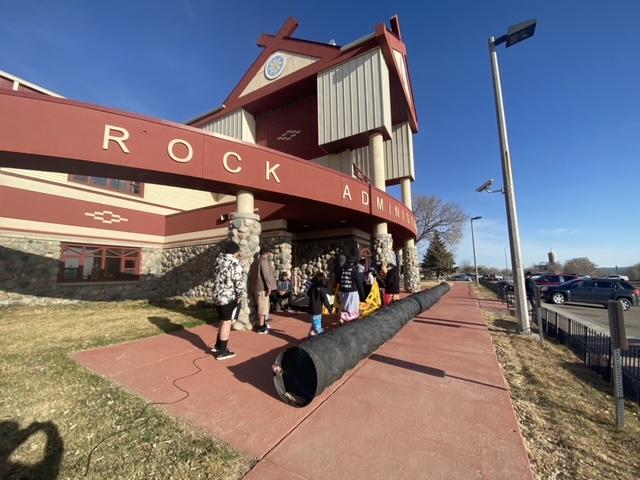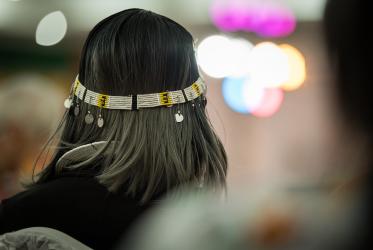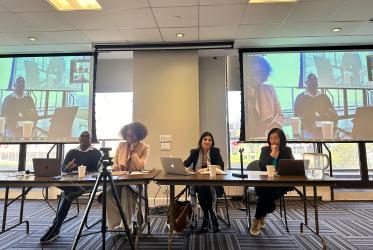The visits were hosted by the Standing Rock Episcopal Community, Dakota Goodhouse, and North Dakota Council on Indian Ministries, all of which have been strongly engaged in advocacy related to the Dakota Access Pipeline protests, grassroots movements that began in early 2016 in reaction to the approved construction of Energy Transfer Partners' Dakota Access Pipeline in the northern United States.
The pipeline was projected to run from the Bakken oil fields in western North Dakota to southern Illinois, crossing beneath the Missouri and Mississippi rivers, as well as under part of Lake Oahe near the Standing Rock Indian Reservation.
Many in the Standing Rock tribe and surrounding communities consider the pipeline to constitute a serious threat to the region's water. The construction is also seen as a direct threat to ancient burial grounds and cultural sites of historic importance.
Jon Eagle, tribal historic preservation officer of the Standing Rock Sioux Tribe, recapitulated the 2016 protests, when over 300 tribal nations came to protect the waters of Standing Rock, something that had not happened since the 18th century.
“The camp had up to 15,000 people protesting. Our message was: we don’t have to be dependent on fossil fuel!”
Despite the difficult and painful reality, Eagle sees hope for the future generation through a pedagogy made to shape young minds. “The struggle is not yet finished. But we have set a good example to our children to show hope to a newer generation,” he said.
“Our people have been traumatized by the past. This country doesn’t keep its promises, and they allowed the oils to flow into the water. Colonisers claimed the land as they said it was unused, but it was actually that the original people had not over-exploited it,” added Eagle.

The Oceti Sakowin Camp on the bank of the Cannon Ball River in the fall of 2016.
Rev. John Floberg, supervising priest of the Episcopal churches on the North Dakota side of Standing Rock, described the 2016 protest as “the most powerful experience in my 25 years on Standing Rock.”
Floberg called the clergy to come in defence of the water protectors. Over 500 hundred showed up. "It was important to get the churches involved in the protests of Standing Rock, to express solidarity. Also, the law and order were mild on church leaders protesting from the front,” he said.
The Episcopal Church’s ministry to the protestors opened what he called the “evangelical window of the gospel” between the Christian churches and Native Americans, “versus all the racism that has reared up so ugly in North Dakota.”

Luke’s Winter Count displayed at St. Luke’s Episcopal Church with a par flesh Gospel Book on the Altar.
The Pilgrim Team visit conversations also addressed the impacts of water injustice, the encroachment of sacred waters and land, displacement, racism, and trauma around Standing Rock and across North America.
The Venerable Paul Sneve, archdeacon of the Episcopal Diocese of South Dakota, reflected on the painful past of the relationship between Christianity and the culture of the Lakota people.
“Christianity in a way was forced upon the natives and expected them to leave their culture and embrace Christian belief and practice. But many Lakota people see Jesus as one of their own because of his traits,” he said.
“People have to be able to see Jesus as one of their own or they will never be a good Christian. More Christians in the world are either black or coloured, and not white. Yet a white Jesus is projected and white Christians as power holders fool themselves that all Christians throughout the world are like them,” added Sneve.
He concluded stressing that “our dominant society don't see the sacramental nature of land and water and that only serves to hurt indigenous people.”
The program of the visit also included time to revisit “Seven Weeks for Water,” the WCC’s Ecumenical Water Network 2021 Lenten campaign on water justice, through an encounter with the seven authors of the reflections of water justice in the North America region.
The Pilgrim Team Visits are a mechanism developed within the WCC’s Pilgrimage of Justice and Peace to identify and accompany with the struggle for justice and peace of communities. This year, they have a regional focus on the North America region.
Learn more about this Pilgrim Team Visit to Standing Rock
Learn more about the Pilgrim Team Visits in North America:
Arctic communities to WCC pilgrims: “We need your voice” - WCC feature story 11 May 2021






